Archive for the 'The Frodo Franchise' Category
Once more on New Line, Peter Jackson, and The Hobbit
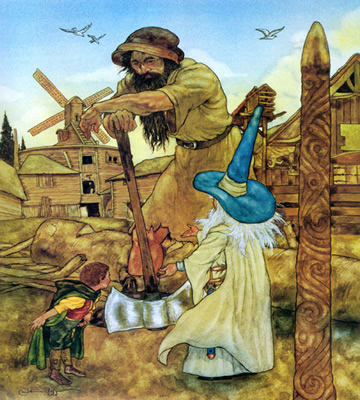
Gandalf introduces Bilbo to Beorn. Illustration by Michael Hague
Kristin here–
After several months of raised and dashed hopes, the question of who will direct the film of J.R.R. Tolkien’s The Hobbit remains open. I first weighed in on the question back on October 2 of last year, when this blog was in its infancy. MGM had just announced that they would be making The Hobbit and hoped that Peter Jackson would direct. At that point I was trying to sort out Peter Jackson’s large number of film projects and to explain how his schedule might include time to direct The Hobbit.
Subsequently there was a clarification. MGM, which owns the distribution rights to any film version of the novel, would co-produce with New Line, which produced The Lord of the Rings and owns the filmmaking rights for The Hobbit.
Then, early this year, New Line founder and co-president Bob Shaye declared in an interview that Jackson would never direct The Hobbit while he is in charge of the company. The obstacle was a lawsuit that Jackson had filed against New Line; he wanted an accounting of earnings on the DVDs of The Fellowship of the Ring and various licensed products. See my January 13 attempt to explain all that.
As before, no doubt negotiations are going on behind the scenes. To reiterate my disclaimer from the earlier entries, I have no inside information, given that my contact with Jackson and the other filmmakers was back in 2003 and 2004, during the research for The Frodo Franchise. As someone who has followed the situation very closely since undertaking my book back in 2002, however, I can make what I hope are some enlightening comments on the scraps of news that have appeared since January.
A faint hint that Shaye might possibly be backing away from his absolute rejection of Jackson as director for The Hobbit came in a brief interview in the April issue of Wired (also online). As far as I could tell, this went largely unremarked at the time. The first two questions related to The Last Mimzy, the children’s fantasy directed by Shaye, which was then being released to what proved to be disappointing box-office results. Inevitably, though, the interviewer switched to the Hobbit situation:
You recently said Peter Jackson would never touch The Hobbit while you were at New Line.
You know, we’re being sued right now, so I can’t comment on ongoing litigation. But I said some things publicly, and I’m sorry that I’ve lost a colleague and a friend.
Is The Hobbit still a viable project?
I can only say we’re going to do the best we can with it. I respect the fans a lot.
Shaye’s statements might be seen by some as implying that he regretted his rejection of Jackson as a director. Given that the vast majority of fans want Jackson to direct, the last sentence seems to offer hope that Shaye might relent and bow to their wishes.
A greater stir was caused by Entertainment Weekly’s April 16 announcement that Sam Raimi had expressed interest in directing The Hobbit—a possibility that had been circulating widely as a rumor since shortly after Shaye’s January pronouncement. As I suggested in my previous entry, however, most directors would shrink from upsetting Jackson and his fans by simply taking the job. Raimi made it clear what circumstances would be necessary: “First and foremost, those are Peter Jackson and Bob Shaye’s films. If Peter didn’t want to do it and Bob wanted me to do it—and they were both okay with me picking up the reins—that would be great. I love the book.” (Raimi presumably refers to films in the plural because MGM had suggested in September that it was considering a two-part adaptation.)
Raimi risked riling not only Rings fans but Spider-Man afficionados, who were upset at the idea that he might bow out of a presumed fourth entry in his own franchise. In the nearly two months since Raimi’s statement, there has been no public indication that he is being seriously courted to accept the job directing The Hobbit.
Jackson, however, has been busy. The projects on his plate have changed considerably since early October. Only a few weeks after my summary, Universal and Twentieth Century Fox, which had been on board to finance the video-game-to-film adaptation of Halo for co-production by Jackson and Microsoft, bowed out. The project is now on hold, with the assumption that the release of the Halo 3 game, announced for September 27, will regenerate studios’ interest.
The remake of The Dam Busters is moving forward, but it is being directed by Christian Rivers rather than Jackson, who serves as producer. The acquisition of Naomi Novik’s “Temeraire” series by Jackson and partner Fran Walsh, announced September 12, apparently has not resulted in a specific project. The pair presumably have the option of making it into a film at some future date or letting their option lapse.
The project that has made great progress is Jackson and Walsh’s adaptation of Alice Sebold’s bestseller The Lovely Bones. Their script was up for bids this spring, and on May 4, Variety announced its sale to Dreamworks. Reportedly the film will be delivered by the fourth quarter of 2008. It might be possible to commence pre-production work on a Hobbit film while The Lovely Bones is in progress.
Less than two weeks later, Variety revealed that Steven Spielberg is teaming with Jackson to produce three feature films based on the classic Belgian comic books starring Tintin. Each plans to direct one of the features, with a third director undertaking the other.
In October I suggested that most of Jackson’s projects were flexible in their timing, and that left the possibility that he could shift them around to fit in The Hobbit. Given that no timing has been announced for the Tintin films, Jackson’s only apparent project with a deadline is The Lovely Bones.
Finally, at the Cannes Film Festival, Shaye and co-president of New Line Michael Lynne spoke to Variety’s editor-in-chief, Peter Bart, about the Hobbit project. Their remarks might give Rings fans cause for hope.
Shaye maintained his stance, declaring that New Line had paid Jackson and Walsh $250 million in profit participation. “The clash happened because ‘one of us has gotten poor counsel,’ Shaye said, without elaborating.”
The story continues: “Co-chief Michael Lynne struck a more upbeat note. ‘We do want to settle our dispute and I think we will.’” Neither would comment on the rumors that Raimi was being wooed for the Hobbit adaptation. When asked about Raimi, Lynne replied, “There’s never been any announcement.” Shaye added, “Like a lot of people, he might.”
I think there are two major factors underlying this feud between Jackson and Shaye that haven’t been pointed out and need to be. First, lawsuits of the type Jackson brought are pretty common in Hollywood. Second, Shaye is perhaps forgetting the amount of personal investment and financial risk Jackson took to get Rings made—investments that cost New Line nothing but which brought in a hugely successful film on a surprisingly low budget. (I explain how in the first chapter of The Frodo Franchise.)
Jackson’s isn’t even the first suit against New Line by someone central to the film’s making. Independent producer Saul Zaentz sold the adaptation rights to Miramax back in 1997, and that company in turn sold them to New Line in 1998. As part of these deals, Zaentz was to receive 5% of gross international receipts. He sued, claiming that the $168 million paid to him was calculated on net receipts, leaving a balance of $20 million owed him. The suit was to come to court on July 19, 2005, but New Line settled for an undisclosed amount shortly before that. The same thing could happen in Jackson’s case, and the settlement could come at any time.
Zaentz isn’t the only other person claiming to have been shortchanged by New Line. On May 30 of this year, a group of fifteen Kiwi actors filed a suit claiming that they had not been paid the 5% of net merchandising revenues for products bearing their likenesses. (The group includes Sarah McLeod, who played Rosie Cotton, Craig Parker, who played Haldir, and Bruce Hopkins, who played Gamling.) The suit isn’t likely to reach court soon, if ever, but Jackson isn’t alone in his doubts about New Line’s accounting practices.
Moreover, Jackson and Walsh spent an enormous amount of their own money upgrading the filmmaking firms in Wellington to make them sophisticated enough to handle all phases of Rings’s production. Weta’s two halves, Digital and Workshop, of which the couple owns a third, were vastly enlarged. Jackson and Walsh bought the country’s only post-production facility, The Film Unit, when it was for sale and under threat to be moved out of New Zealand. They went into debt to do that, and it, too, was enlarged and moved into a huge facility full of highly sophisticated equipment. Much of this expansion was paid for with the money Jackson received for making Rings.
The result was a trio of films that grossed nearly $3 billion internationally, as well as untold additional revenues for the DVDs, video games, and other ancillaries. New Line went from a small subsidiary of Time Warner known mainly for its Nightmare on Elm Street series to a well-respected company making prestige films like Terence Malick’s The New World and the upcoming The Golden Compass, an adaptation of the first novel of Phillip Pullman’s award-winning trilogy. Oh, and there’s the matter of the seventeen Oscars Rings won. Previously New Line, founded in 1967, had won two.
In the wake of Rings, Jackson was faced with having to keep Weta, The Film Unit (now renamed Park Road Post), the Stone Street Studios, and his WingNut production firm going. Beyond the physical facilities, which no doubt involve enormous overhead costs, there are the many hundreds of employees to be paid. New Line did not invest in these facilities. Jackson and Walsh, along with their partners Richard Taylor and Jamie Selkirk, did.
When I first visited Wellington, there was a question as to whether there would be enough business to keep the facilities going and the employees in work. King Kong helped in the short run, but would other big films follow? Since then, Weta Workshop has diversified and is thriving. Weta Digital gets regular work doing the CGI for large numbers of shots in such films as X-Men 3: The Last Stand and Eragon. James Cameron’s decision to make Avatar in Jackson’s facilities seems the final seal of approval. Weta Digital is now widely considered one of the top digital effects houses in the world, alongside such firms as ILM, Sony’s Imageworks, and Rhythm & Hues.
Now the Wellington facilities all seem to be doing well. Nevertheless, in the era before Rings’s release and huge success, Jackson took as big a risk as Shaye did. Maybe bigger. Shaye might ponder that as he decides what to do about the Hobbit project. He owes the Kiwi filmmaker gratitude for more than simply directing a runaway hit.
Beyond that, unless New Line has short-changed Jackson very badly through its accounting procedures (and all that would presumably come out eventually when the suit finishes up), the added value provided by the director’s name on a Hobbit film would surely be at least as great as the money owed. Unless there is some major unknown factor influencing Shaye’s decision, he would do well to tamp his resentment, make peace, and initiate a project that is as close to a guaranteed mega-hit as anything can be these days. He could settle out of court, as he did with Zaentz, and just get on with it.
[Added July 21: For my update on the Hobbit film, go here.]
[Added August 6: For my earlier comments on the Hobbit film, go here and here.]
Kia ora from New Zealand
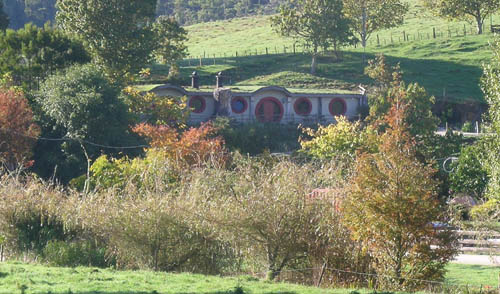
KT here:
David and I have been fairly busy during our first week and a half as Hood Fellows at the University of Auckland. Our hosts have kindly scheduled all our talks for early on in our stay, leaving time to see the attractions of Auckland and its surroundings.
This past Sunday we took a tour of some of the Waitomo Caves, famous primarily for caverns in which thousands of glowworms light up the ceiling like so many stars. It’s quite a long ride by bus to reach the area. This happens to be the off-season for tourists in New Zealand, May being the equivalent of the Northern Hemisphere’s November. So far, however, we’ve actually experienced a streak of unseasonably warm, sunny weather.
We happened to be the only passengers on the bus going down to Waitomo, though there we joined a group totaling seven for the actual cave tour. On the way, we initially saw lots of fog and then spectacular mountains and valleys. That part of New Zealand is largely devoted to dairy farms, so we saw many bucolic landscapes full of cows.
Our driver, Pete, regaled us with many stories, including how a group of tourists had dubbed his bus (then brand new) Tillie. Pete hadn’t recognized the connection to the old Walter Matthau-Carol Burnett movie Pete ‘n’ Tillie, but he liked the name and has used it ever since.
As we neared Waitomo, Pete took us off the main route onto a more scenic road. As we drove, he pointed out Woodlyn Park, a motel with themed rooms, including two “hobbit holes.” These look fairly similar to the facades used in The Lord of the Rings, except that the two fronts are joined at the middle, like a Middle-earth duplex, or as the British say, semi-detached. The furniture inside apparently is people-sized rather than appropriate for hobbits. The photos on the motel’s website look somewhat incongruous, with their modern stove and sink, but the beautiful surroundings suggest that for a fan doing an independent driving tour through New Zealand, this would be a pleasant place to spend the night.
I had been aware of Woodlyn Park from the period when I was scanning for internet for LOTR-related products for The Frodo Franchise. I had never particularly taken note of where it was, so this unexpected chance to see it, if only from the road, seemed like a fortuitous coincidence.
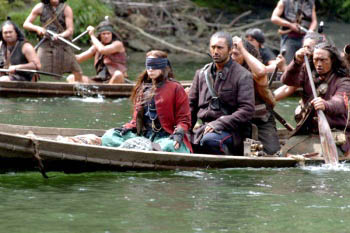
In my previous entry, I mentioned that Māori TV is running a series of classic New Zealand films on Sunday nights. We got back from our Waitomo trip just in time to catch Vincent Ward’s first feature, Vigil (1984). It’s an impressive debut, with brooding images of harsh landscapes punctuated by startling cries of birds. The result looks like a blend of Bergman and Tarkovsky.
The film deals with a girl living with her parents on a struggling sheep farm and her efforts to understand the baffling events happening around her without much guidance. Her father is killed trying to retrieve a lost sheep, and her mother, embittered by her lost dreams of becoming a ballerina, tries to force her tomboy daughter to start practicing in the hope that they soon can leave the farm behind. Into all this wanders a vaguely threatening poacher who may or may not have illicit designs on the heroine.
Told largely from the girl’s point of view, the result is a grim but fascinating study in character and mood. It’s a pity that Vigil is not currently available on DVD, though used copies with various region codings are knocking around the internet.
By the way, I managed to see Ward’s most recent film, River Queen (above), at the American Film Market in 2005. Apart from in New Zealand, the film has had virtually no distribution, apparently going direct to DVD in some countries. (It’s currently available from German Amazon and on pre-order status at French Amazon.)
Again, it’s a pity, because although it’s not a masterpiece, it’s an entertaining and engaging period adventure involving a woman who goes into the New Zealand wilderness to rescue her kidnapped son. It is done on an epic scale that deserve to be seen on the big screen. Rumors of various problems that plagued and prolonged the filming have given River Queen an undeservedly bad reputation. Apart from a bit of choppy exposition at the beginning, I saw few signs of the fact that Ward had not been able to finish all the planned footage.
Samantha Morton’s illness (and rumored clashes with Ward) delayed the film, but she gives an intense and convincing performance. So does Cliff Curtis, an excellent Māori actor (The Piano, Once Were Warriors, and Whale Rider) who has also turned into an all-purpose ethnic player, cropping up in a wide variety of roles—often Arabs—in such films as Three Kings, The Insider, and the current Sunshine.
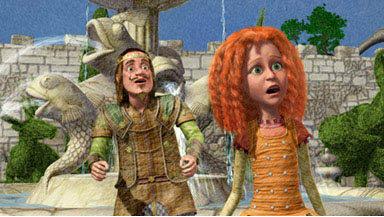
I also mentioned that Jane and the Dragon, a children’s television series co-produced by Weta Workshop, was premiering here on May 19. Upon further research, I discovered that the series played in Canada and Australia way back in October of 2005. It premiered on September 9, 2006, on NBC in the US. (I don’t follow children’s television, so I had missed watching it then.)
The series is one of several in the Qubo agreement, whereby NBC and other companies pledge to promote quality children’s television. Perhaps this constitutes an admission that that’s not what we’ve been getting up to now.
The first episode of Jane and the Dragon was charming, though it definitely was aimed at small children. The original book has been reissued as a tie-in to the series, and the Amazon description lists it as suitable for ages 4 to 8.
For me the series’ main interest lies in the innovative technique Weta Workshop has developed to aid in the CGI. When I first interviewed Richard Taylor, head of the Workshop, back in October, 2003, he emphasized that his company depended very little on digital technology. In contrast, the other half of Weta Ltd., Weta Digital, is entirely computer-based, providing the cutting-edge CGI not only for The Lord of the Rings but also King Kong and sequences in I, Robot, X-Men 3: The Last Stand, Eregon and others. By our second discussion, in December, 2004, Weta Workshop was moving more toward digital technology. A new motion-capture studio was just beginning to be tested. No doubt the Workshop’s designers will continue to emphasize real props, maquettes, prosthetics, and similar objects, but it has branched out.
The result in Jane is a world that resembles a series of detailed colored-pencil illustrations from a children’s book. The world is three-dimensional, however, with the characters created in sophisticated motion capture and the “camera” gliding freely through the “drawn” space. The effect is a little disconcerting at first, with the characters in lively motion and the backgrounds utterly still. Once one gets used to the contrast, however, the effect is pleasant and technically very impressive. Despite the use of motion capture, the characters are stylized rather than realistic, like detailed cel animation but in 3D.
Tomorrow I am scheduled to take the ominously named “Mordor & Mt. Doom Express.” This is a lengthy drive out from Auckland to the area around Mt. Ruhapehu, where Frodo and Sam struggled up the mountain to destroy the Ring (when they were not doing the same thing against blue and green screens in the studio). The point is not just to visit the movie locations from The Lord of the Rings, though. Naturally the filmmakers chose some of the most dramatic scenery in the country to embody Middle-earth—places a tourist would want to visit quite apart from their appearance in the movie.
Then on Sunday I’m headed for a brief stay in Wellington, where I spent many exciting weeks doing the interviews and facilities tours that constituted much of the research for The Frodo Franchise. I hope to be able to report from there in my next entry.
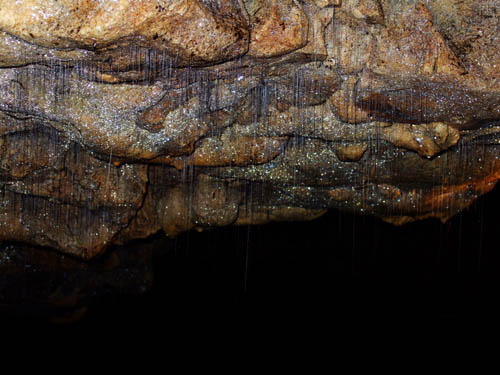
Glowworms show up as tiny green lights. They spin single strands that hang below them and catch small insects drawn into the cave by air currents.
A scoop from Auckland
It’s still Friday for many of you, but here in Auckland it’s Saturday, and the “Weekend Review” section of the New Zealand Herald has run a story about our visit to the university. It’s by Peter Calder, who has reviewed films for the Herald since 1984. We had a pleasant chat with him in preparation for the article. With all his film experience, Peter is one of those rare reporters who puts the quotations in their proper context and gets his facts right. You can read the article, “Figuring out the Frodo Franchise,” and its sidebar, “Technical tricks of the trade,” in the Herald‘s online version.
Dispatch from the Land of the Long White Cloud
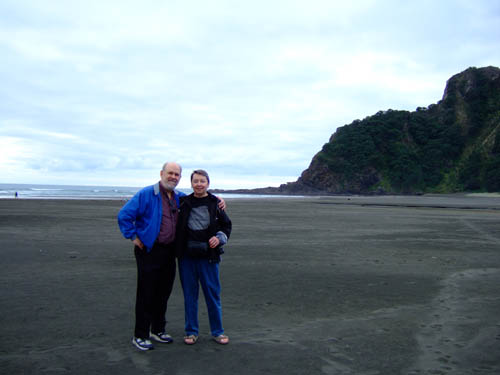
Kristin here—
David and I are currently in New Zealand. The University of Auckland offered us both Hood Fellowships, and we will be in residence here for the month of May.
After settling into a hotel room with a splendid view of part of the Auckland harbor and downtown, we were shown around the campus by our host, Brian Boyd, Nabokov scholar extraordinaire. We’ll be giving lectures in classes and to the public over the next week and a half. I’ll also be doing some media interviews relating to The Frodo Franchise, which is due to be published here by Penguin New Zealand, probably in early September. Today, in fact, I met my editors and publicity person at Penguin.
Yesterday Brian and his wife Bronwen Nicholson drove us out to the Waitakere Ranges Regional Park, a large area on the coast west of Auckland. The park is spectacularly beautiful in itself, but our goal was Karekare Beach, one of several black-sand beaches within the park. It was the location where the beach scenes of Jane Campion’s The Piano were shot and even now remains a popular tourist destination. There we are (above), more or less at the spot where Holly Hunter’s character brought her piano ashore in her new home.
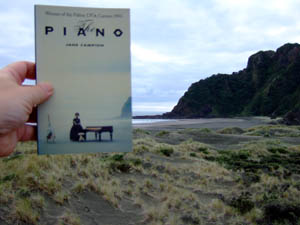
Naturally we have also done some book and DVD shopping. When I first came to New Zealand to work on The Frodo Franchise, back in September and October of 2003, there were almost no Kiwi films on DVD: Once Were Warriors, of course, and Whale Rider, the two most popular New Zealand features, and a few others.
As I discuss in the book (Chapter 10), The Lord of the Rings had a beneficial impact on New Zealand cinema. In large part because of the trilogy, filmmakers gained new skills, new production infrastructure was created, local directors and other talent returned from jobs abroad, and government funding increased. Kiwi films became more popular within their own country. When I talked to Dr. Ruth Harley, CEO of the New Zealand Film Commission, in late 2005, she declared that the national cinema was perhaps having its best year ever, and the momentum does not seem to have slowed.
One sign of success is that one can now find some of the older classics on DVD. There’s actually a “Roger Donaldson Collection” series. (That’s the same Roger Donaldson who is more famous in U.S. for The Bounty, Dante’s Peak, and Cocktail.) We picked up his Sleeping Dogs (1977), notable as the first New Zealand film to play in American theaters, and Smash Palace (1981), the movie that led to his career abroad. A DVD set from this series containing both films is available in the U.S.
I saw Donaldson’s latest, The World’s Fastest Indian (2005) at the American Film Market in 2005—the same occasion upon which I interviewed Dr. Harley for the second time for my book. I opined to her that the film might well be a considerable success in the US. It’s an engaging and entertaining film with Anthony Hopkins giving a marvelous performance in the true story of an eccentric Kiwi who tinkered with an old motorcycle (the “Indian” of the title) and set a world speed record with it.
Unfortunately The World’s Fastest Indian was released without much publicity and didn’t do much business in the US. It’s well worth seeking out on DVD.
There are other signs of increased interest in local films. Geoff Murphy’s hit film Goodbye Pork Pie (1981), previously available on a PAL DVD without region coding, has come out in a “Special Collector’s Edition” with a new transfer, a stereo soundtrack not included on the original release prints, and a second disc of extras. Three years ago I would not have predicted that an older Kiwi film would get such treatment. Murphy is better known in the art-cinema world for his later Utu (1983) and The Quiet Earth (1985).
Similarly, May 6 saw the inauguration of a series of eight older Kiwi films to be shown weekly on Sunday nights until June 24 on Māori Television, one of the national channels in New Zealand. Most of these are not specifically oriented toward Māori subject matter—perhaps further indication that a curiosity about Kiwi cinema in general has spread through the national culture. The opening film, The Last Tattoo (1994), was an engrossing political thriller set in 1943. I look forward to seeing as many of the others in the series as time permits.
Recent DVDs have also allowed me to catch up with two 2006 New Zealand films that I had not had a chance to see yet. Both received favorable reviews from Variety when they played at North American film festivals.
Sione’s Wedding is set among the Samoan community of Auckland. It follows four irresponsible young men as they try to fulfill a condition that will allow them to attend the wedding: they must all find “real” dates to bring along. No. 2 deals with an extended family struggling to organize a traditional Fijian feast on short notice when the matriarch declares that she will name her successor at the event.
Both are made with the sorts of technical resources that one would expect of an American indie film. New Zealand films still work with small budgets, but funding is distinctly larger than in the pre-Lord of the Rings era. Strikingly, both of these films deal with the familiar situation of a big family event where irresponsible men must be led to maturity by their women. Both are also highly enjoyable, especially No. 2, with its skillful blend of humor and sentiment and its powerful performance by Ruby Dee as the matriarch.
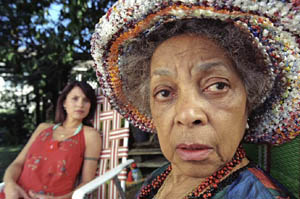
Sione’s Wedding, retitled Samoan Wedding for the North American release, received an enthusiastic review from Variety after its premiere at the Montreal World Film Festival late last summer. Magnolia released it on November 10, 2006, with a run of 14 weeks. It started in two theaters, with a respectable $7,852 average on its opening weekend. Eventually it played in only three theaters, made $72,244, and disappeared. It did, however, come out on DVD.
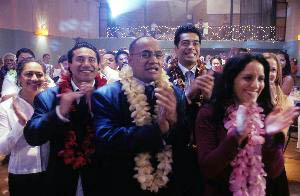
No. 2, also well-reviewed by Variety, is apparently to be released in the U.S. under the title Naming Number Two. For those living in or near New York, it will be shown on May 10 as part of the Pacifika Showcase series.
By a happy coincidence, next Saturday on TV2 at 5:30 pm, I’ll be able to watch the premiere of the children’s animated series Jane and the Dragon. Back in October 2003, when I interviewed Richard Taylor, head of Weta Workshop, he mentioned that he was trying to diversify the company’s projects so as to be able to offer steady work to his employees. One project was this series, for which he was then seeking financing.
Just over a year later, in early December 2004, I interviewed Richard again. By another coincidence, that was the day when Weta was beginning to test its new motion-capture studio that had been created to help in the production of Jane and the Dragon and other projects. Now at last the series is finished.
It’s already playing on Canadian TV, and the YTV.com site offers an entire episode for viewing here. The official website, aimed specifically at children, is here.
I hope to report back on it and other media-related experiences here in New Zealand, or Aoteroa, which means “The Land of the Long White Cloud.” It’s a well-deserved name. Anyone who thinks the mountains and other unspoiled landscapes shown in The Lord of the Rings and The Lion, the Witch and the Wardrobe were created by CGI are mistaken. Much of New Zealand actually looks like that. I’m hoping to visit a few of the film locations that I haven’t seen on previous visits.

The view from our hotel balcony.













